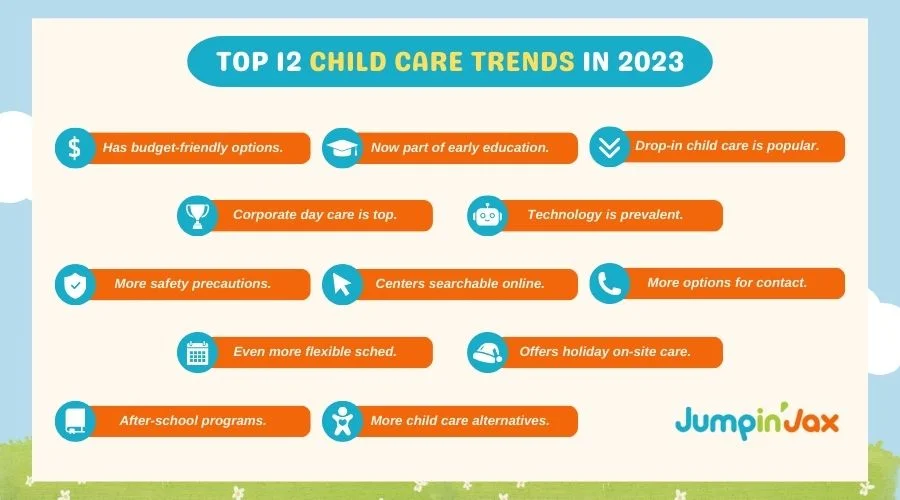Most parents and childcare providers agree that the reforms to the system are for the better. What are some of the most recent developments in child care, and what qualities must parents consider before making a crucial choice? Paramus Day Care may help you discover more about childcare.
1. Child Care Is Serving Families on a Budget
A growing number of parents are scrutinizing the cost of child care and choosing to cut hours or even remove their children from structured programs entirely because of financial hardships or job losses that also impact childcare providers. To entice families to remain, many providers are providing flexible hours, maintaining or even lowering fees in some situations, and arranging payment plans for financially strapped families. To save costs without compromising care quality they provide children, caregivers are also closely examining any special programs or fees.
2. Child Care is Now Early Education
Child care for young children is no longer just babysitting. Childcare facilities have generally evolved into centers for early education, where young children participate in early learning. The rise in learning centers is due in part to high parent and school expectations; it is also due to studies showing that children are capable of acquiring early academics and other abilities that were traditionally not taught until later. Care facilities often include established early education curricula, and personnel have significant training in preschool teaching.
3. Drop-in Child Care Is Increasingly Popular
The growing popularity of drop-in child care is not surprising. Some may be surprised that these institutions usually provide safe, effective, and reasonably priced treatment alternatives. To give parents a worry-free evening or time away from their children, drop-in care centers prioritize entertaining activities for youngsters. These activities often include mealtimes and special theme events. Parent Nights Out and related programs are offered by gyms, leisure centers, churches, and even schools. In the future, expect to see even more flexibility in this trend.
4. Corporate Daycare Is Increasing The Bar for Quality
Corporate child care is increasing the bar in terms of child care quality. A growing number of businesses are providing (or contemplating providing) in-house childcare facilities as a benefit for recruiting and keeping top talent. Furthermore, more companies are collaborating with childcare institutions to provide lower prices or even unique hours for workers. Some developers are even integrating a child care facility in the master planning of new regions, recognizing that having a quality child care center nearby would make the area more appealing for businesses and workers.
5. Technology Is Modifying the Parent/Provider Relationship
A growing number of childcare facilities provide parents with the peace of mind of checking in on their kids while at daycare as needed via video streaming classroom events throughout the day. Other providers snap images of children and send them to parents regularly, publish daily or weekly blogs or e-newsletters online for parents to read, or even exchange emails or text messages during the day. The technology gives parents and caregivers another tool for keeping in contact and connecting with their children’s activities and events.
6. Most Daycare Facilities Are Growing Safer
The majority of childcare providers are taking more precautions to safeguard the children in their care, even if no system is 100% fail-safe, and tales of child pornographers or sex offenders working near children will inevitably continue to surface. Safety is being improved via tighter security regarding kid pickup, more thorough background checks and screenings of potential hires, and more monitoring and surveillance (both overt and covert). Additionally, contributing to children’s safety on field excursions and outings are training and more comprehensive checks.

7. There Are More Options for Childcare
Today’s parents have access to a broader range of childcare alternatives, and many families decide to employ several providers depending on their specific requirements. A nanny for a baby, an in-home caregiver for a toddler, and a daycare facility for a preschooler are some options available to families. Certain families choose one kind of care during the academic year and a different one over the summer. Options for occasional care services include babysitters, drop-in care, parent night-out evenings, and cooperative child care. Opportunities are abundant in most places, but sometimes, you must look hard for them.
8. How to Locate Child Care Using the Internet
Previously, the most popular methods for finding child care were by word of mouth or driving around a neighborhood. However, many families, particularly those relocated to a new area, depend on the Internet to discover high-quality child care. Free lists of child care may be found on several websites; most states also have child care websites that can be reviewed. There is a growing number of web-based babysitting and childcare services available. Parents may search for providers that fit the specified criteria by typing in a zip code. More and more business owners are promoting the availability of child care. Of course, reference checks are indispensable.
9. There Are More Useful and Frequent Communications
Parent and child care provider communication is still growing in today’s right away, “tell me now” environment. Instead of relying on monthly newsletters to accompany daily welcomes and farewells, childcare providers are now using an array of resources to provide parents with continuous updates about their kid’s day. On their websites, several suppliers include monthly menus, weekly activity summaries, and even behavior reports. Some provide a daily update to parents via email, composed while they sleep. Face-to-face communication is still the greatest, despite technological advancements.
10. Child Care Services for Busy Working Parents
Have you noticed how more and more daycare facilities are providing enrichment activities for young children to engage in while they are still there? Even if they want their kid to engage in a variety of activities at the same time, parents nowadays are busy than ever.
For others, the answer is to enroll children in optional, fee-based weekday ballet, karate, soccer, and gymnastics lessons while they are still under care. Instead of the other way around, the facility comes to the educator. While this kind of solution may only be suitable for some, it does work well for those who lead hectic lives or have daily commutes.
11. Holiday Spots, Family-Friendly Hotels with On-Site Care
Many resorts and tourist-based towns have established on-site or nearby child care to persuade parents to stay at a specific hotel or region. While some facilities charge a fee for children to participate, others are free and feature crafts, special movie nights, field excursions, and other activities. As appealing as it may be, make sure that you properly inspect the facility and are satisfied with the regulations, safety procedures, staff training, health practices, and activities scheduled for the children. If everything checks out, have a good time!
12. Child Care Flexibility is provided via after-school programs and care.
Selecting a high-quality after-school care program may have a significant influence on your child’s academic performance, self-esteem, and general happiness. Many daycares drive school-aged children from school to the center, provide a nutritious snack, and then begin working on homework so that it is primarily completed by the time parents arrive. Some schools also offer on-site activities to keep children from returning home to an empty house while their parents work.






